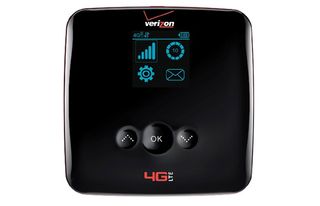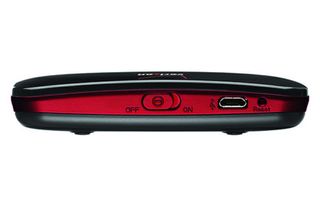Laptop Mag Verdict
Verizon's ZTE-built hotspot can connect 10 Wi-Fi-enabled devices and offers fast 4G LTE speeds.
Pros
- +
Fast overall performance
- +
Supports 10 Wi-Fi-enabled devices
- +
Global Ready
Cons
- -
Display nearly impossible to read outdoors
- -
Interface less intuitive than MiFi
- -
Large size
Why you can trust Laptop Mag
The Verizon Jetpack 4G LTE Mobile Hotspot 890L seeks to repeat the success of the carrier's sickeningly fast $49.99 Jetpack MiFi 4620L. And with the ability to support up to 10 devices, global connectivity and a lower price of just $19.99, it would seem that the Jetpack 890L would be a steal. So is the 890L the best hotspot on Big Red's network? Read on.
Design

Click to EnlargeMeasuring 3.5 x 3.5 x 0.7 inches, Verizon's Jetpack 890L by ZTE has the largest footprint of any hotspot we've tested. And at 4.8 ounces, it's a hair shy of being the heaviest as well. That distinction falls to Sprint's Sierra Wireless 4G LTE Tri-Fi Hotspot, which weighs 4.9 ounces. The Jetpack is shaped like a flattened square and features a slightly domed top covered in a glossy black paint that easily picks up fingerprints. ZTE gave the Jetpack's sides a slick red paint job to match Verizon's color scheme.
Unlike the AT&T Elevate 4G and the Sprint Sierra Wireless 4G LTE Tri-Fi Hotspot, the Verizon Jetpack 890L features a green-and-black OLED display, rather than a full color display. Overall, we found the Jetpack's screen exceedingly difficult to see under office lighting and nearly impossible to view outdoors.
Below the display are the Jetpack's capacitive Up, Down and OK buttons. Up top, along the Jetpack's top edge, you'll see its microUSB port and physical On/ Off switch, a novelty on a hotspot.
Overall, we found the Jetpack 890L's capacitive buttons to be a chore to use. The home screen offers only four options, which you have to dive into to reach basic settings. Navigating menus using the Up and Down buttons frequently caused us to accidentally switch menus. By comparison, the Verizon Jetpack 4G LTE Mobile Hotspot MiFi 4620L's home screen provides users with a series of menu options and physical Left and Right buttons, making nagivation a lot easier.
4G LTE Coverage
With 337 markets, Verizon's 4G LTE network dwarfs both AT&T and Sprint's networks, which cover 51 and 15 markets, respectively. Big Red promises download rates of 5 to 12 Mbps. Heading overseas? The Jetpack 890L is CDMA and GSM-enabled so you'll be able to use it in more than 200 countries.
Features
The Verizon Jetpack 4G LTE Mobile Hotspot 890L allows users to connect an impressive 10 Wi-Fi-enabled devices when running on Verizon's 4G LTE network and five devices when connected to 3G. We appreciated the fact that you can charge the Jetpack via your laptop's USB port while still broadcasting a Wi-Fi signal. We were, however, disappointed to find that this Jetpack doesn't include a microSD card slot, something both the AT&T Elevate 4G and Sprint Sierra Wireless 4G LTE Tri-Fi Hotspot include.
The Jetpack 4G LTE Mobile Hotspot 890L's Web interface provides users with access to the hotspot's WAN, Router, Firewall and Wi-Fi settings, as well as SMS messaging. You can even reset the hotspot or factory restore it using the Web interface's Advanced menu.
Performance

Click to EnlargeThe first Jetpack 4G LTE mobile Hotspot 890L turned in a woefully inconsistent performance. Using Speedtest.net, we measured the hotspot's upload and download speeds at three locations in New York: Madison Square Park, Union Square and Bryant Park. The Jetpack 890L averaged just 3.1 Mbps down, and 3.2 Mbps up. That's well below the 5 to 12 Mbps Verizon claims for its 4G LTE network, but the upload speeds were generally within the carrier's 2 to 5 Mbps range. By comparison, the AT&T Elevate 4G averaged 12.4 Mbps down, and 8.3 Mbps up.
We then tested the Jetpack 890L to see how it would perform under stress conditions by re-running Speedtest.net while streaming a 720p video to a laptop. While throughput was still quite low -- 2.3 Mbps down and 4.8 Mbps up -- at least it wasn't greatly affected by having more demands placed on it.
When we brought the JetPack 4G LTE Mobile Hotspot 890L's poor download speeds to the attention of Verizon, the carrier sent us a second unit. That hotspot at first wouldn't let us connect to Verizon's 4G LTE network, but when we took it to Jersey City, N.J., it performed exceedingly well. Download speeds averaged 17 Mbps and uploads averaged an impressive 10.2 Mbps.
We then took the 890L back to New York City to give it another go. Surprisingly, speeds improved drastically, with downloads averaging 7.3 Mbps and uploads averaging 5.7 Mbps. Still, the 890L couldn't match the performance of Verizon's MiFi 4620L, which averaged 10.9 Mbps down and 8.5 Mbps up.
Large File Downloads
On average, it took the first Jetpack 890L we tested a whopping 10 minutes to download the 145MB OpenOffice install file. That's about 7 minutes longer than the both the AT&T Elevate 4G and the Sprint Tri-Fi. At least it was more consistent than the T-Mobile Sonic 4G Mobile Hotspot, which took anywhere from 3 minutes and 8 seconds to 4 hours to download the same file, depending on the location.
When we tested the second Jetpack 4G LTE Mobile Hotspot 890L in New York, we downloaded OpenOffice in 2 minutes and 17 seconds, faster than the 4 minutes and 18 seconds it took to download the file using the Verizon Jetpack 4G LTE Mobile Hotspot MiFi 4620L.
Web Surfing
Our first Jetpack 890L's Web-surfing speeds were fairly disappointing. On average, loading CNN.com took 9.2 seconds, NBCNews.com took 13.5 seconds and Laptopmag.com took 13 seconds. By comparison, Sprint's Tri-Fi loaded the same sites in 6.5, 5.8 and 7 seconds, respectively, and that was over WiMax.
The second Jetpack 890L performed slightly worse than the first, with CNN.com taking 12.1 seconds, NBCNews.com taking 17.9 seconds and Laptopmag.com 12.3 seconds. Still, the 890L managed to outperform the Jetpack 4G LTE Mobile Hotspot MiFi 4620L, which loaded CNN.com in 15.8 seconds, NBCNews.com in 16.2 seconds and Laptopmag.com in 17.6 seconds.
Battery Life
The Verizon Jetpack 4G LTE Mobile Hotspot 890L's 1700 mAh battery ran for 6 hours and 10 minutes while connected to 4G LTE. That's shorter than the 10 hours and 35 minutes Sprint's Sierra Wireless 4G LTE Tri-Fi Hotspot managed over WiMax, but better than both the AT&T Elevate 4G's 4 hours and 45 minutes, as well as the T-Mobile Sonic 4G Mobile Hotspot, which lasted 4 hours and 55 minutes.
The MiFi 4620L for Verizon lasted 3:57 using its standard battery but a longer 7:32 with its extended battery.
Value
The Jetpack 890L is available for $19.99 with a two-year contract. Contract options range from a 4GB plan for $30 per month all the way up to a 20GB option for $110 per month. Each plan also requires a $20 access fee, meaning a $30 plan will actually cost you $50 per month. If you opt for the 4GB plan, you'll end up paying $1,119 for the length of your contract.
Verdict
Click to EnlargeAlthough the first Verizon Jetpack 4G LTE Mobile Hotspot 890L we tested was slow and inconsistent, our testing of a second device leads us to believe that we had a bum unit. While the 890L's throughput was slower than the MiFi 4620L, it proved faster in real-world tests. Plus, the $19.99 890L is cheaper than the $49.99 MiFi. The reason why we still prefer the MiFi 4620L is its more intuitive interface, smaller footprint and longer battery life -- if you spring for the extended battery.
Verizon Jetpack 4G LTE Mobile Hotspot 890L Specs
| Company Website | http://www.verizonwireless.com |
| Data Connection | HSPA+, EV-DO Rev. A, EDGE, CDMA, LTE |
| Ports | microUSB |
| Size | 3.5 x 3.5 x 0.7 inches |
| Supported Protocols | 802.11a/b/g/n |
| VPN Support | VPN Capability |
| Weight | 4.8 ounces |
| Wireless Bands | 2.4 GHz |
